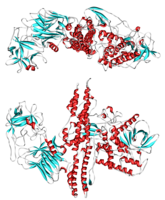
Photo from wikipedia
Sir, On January 30, 2020, the World Health Organization (WHO) declared the emergence of a novel coronavirus (here named COVID-19), firstly reported few weeks earlier in Wuhan, Hubei Province of… Click to show full abstract
Sir, On January 30, 2020, the World Health Organization (WHO) declared the emergence of a novel coronavirus (here named COVID-19), firstly reported few weeks earlier in Wuhan, Hubei Province of China, as a public health emergency of international concern. Since then, drastic countermeasures including shutdowns of public services have been implemented worldwide to reduce virus transmission: on March 9, 2020, the Italian Prime Minister imposed a national lockdown and ordered all hospitals to stop all non-urgent medical procedures, further aiming to release medical capacities for the management of COVID-19-infected patients. Botulinum neurotoxin (BoNT) is a neurotoxic protein produced by the bacterium Clostridium botulinum, which is used in medical practice with a number of different indications including spasticity, dystonia, and chronic migraine [1]. As BoNT injections are usually given every 3 to 4 months, a large number of patients missed their scheduled treatment during the lockdown. Two initial reports described a significant worsening of this group of patients [2, 3], highlighting the importance of BoNT treatment in the management of these chronic conditions. However, these results arose fromuncontrolled studies [2, 3].We here report the results of a case-control study about the effects of the BoNT outpatient clinic shutdown on its patients and their health-related quality of life (HRQoL). Soon after the ease of the lockdown restrictions in Italy on May 4, 2020, our center offered one BoNT extra-clinic per week to reschedule all willing patients who had missed their appointment because of the service shutdown (from here on named “cases”). Patients attending the BoNT service with their usual schedule in the same period served as controls. All patients were asked to rate their perceived worsening on a visual analogue scale (VAS) ranging from 0 (no worsening) to 10 (worst imaginable worsening) in comparisons to the time they had the previous set of injections; similarly, they were asked to rate their attitude to repeat the injection during the lockdown period, would it have been possible. Finally, patients were administered a standardized, two-component, instrument to depict health status: the health state description (EQ-5D), which is measured in terms of five dimensions (namely, mobility, self-care, usual activities, pain/discomfort, and anxiety/depression) and the health state evaluation (EQ-VAS), through which the respondents evaluate their overall health status using a VAS ranging from 0 to 100. To allow comparisons between different BoNT formulations, doses of ONA-BoNT were standardized to ABOBoNT using a constant ratio of 1:2.5 international units (IU). One-hundred thirty-seven patients agreed to participate: 94 cases and 43 controls. Cases had a mean delay of re-treatment of 73.61 ± 26.54 days. There were no differences between cases and controls in terms of age (56.94 ± 17.04 vs 61.72 ± 13.95 years; t = 1.60), sex distribution (43M/51F vs 22M/21F, χ = 0.34), disease duration (11.38 ± 3.40 vs 12.34 ± 2.79 years; t = 1.60), underlying conditions (i.e., spasticity: 37.23% vs 32.55%; dystonia: 40.42% vs 41.86%; migraine: 10.63% vs 11.62%; other: 11.70% vs 13.95%; χ = 2.47), BoNT treatment duration (5.04 ± 5.62 vs 4.7 ± 6.11 years; t = − 0.31), and BoNT doses (659.54 ± 197.11 vs 673.49 ± 193.76 IU; t = 0.03) (for all, p > 0.05). BoNT doses did not differ between groups when stratifying for underlying conditions (data not shown). Cases reported a significant greater worsening of their condition than controls (5.16 ± 3.09 vs 1.83 ± 3.34, respectively, p < 0.001; Fig. 1). However, no differences were found in terms of attitude to repeat the injections, EQ-5D, and EQ-VAS (for all, p > 0.05; Fig. 1). Additional analyses disclosed no significant differences in any of the gather variables within each group, when stratifying for either formulation of BoNT (i.e., ONA-BoNT vs ABOBoNT) or underlying conditions (data not shown). * Roberto Erro [email protected]
Journal Title: Neurological Sciences
Year Published: 2020
Link to full text (if available)
Share on Social Media: Sign Up to like & get
recommendations!